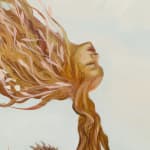-
Artworks
Randa Maddah b. 1983
Hanging Gardens #0, 2023-2024Oil on Canvas146 x 97 cm
57 1/2 x 38 1/4 in
each
DIPTYCH$ 22,000.00SoldFurther images
-
(View a larger image of thumbnail 1
)

-
(View a larger image of thumbnail 2
)

-
(View a larger image of thumbnail 3
)

-
(View a larger image of thumbnail 4
)

-
(View a larger image of thumbnail 5
)

-
(View a larger image of thumbnail 6
)

-
(View a larger image of thumbnail 7
)

-
(View a larger image of thumbnail 8
)

-
(View a larger image of thumbnail 9
)

-
(View a larger image of thumbnail 10
)

-
(View a larger image of thumbnail 11
)

-
(View a larger image of thumbnail 12
)

Exhibitions
2024, Tabari Artspace Solo: Hanging Gardens
Literature
In a research study about the relationship of primitive humans with nature that I encountered during my studies in Damascus, a hypothesis caught my attention regarding the primitive human's perception of natural phenomena as interconnected with their essence. They added their psychological states to these phenomena, making everything around them inhabited by a spirit. This implies that they humanized nature, allowing them to control their fear of it through offerings and other means, such as cave paintings. Hassan Al-Walhazi wrote in his text “Some Characteristics of Primitive Thought and Its Causes”: “The proliferation of spirits in nature and viewing them as conscious beings rather than material entities, and thus establishing a resemblance between humans and nature, is what we call anthropomorphic thinking. It is clear that this tendency towards analogy is based on a subjective inclination. Thus, we arrive at the essence of nature for the primitive: a multitude of spirits manifesting in material forms. Any thought founded on this belief is termed animism. One of its implications is that matter is the 'garment' of the spirit.
The movements of natural phenomena constitute the language of the spirits communicating with humans. The true essence of existence is spirit, while matter is an appearance. In general, its role is to reveal the disposition of the spirit.” The material I present in my project “Hanging Gardens” is a single entity and spirit, representing the longed-for refuge. A spirit shaped by a set of circumstances linked to the harshness and absurdity of reality and the desire to escape for survival. This spirit is embodied and formed in various elements, including trees, birds, humans, and all other composite elements that create the artwork in an attempt to approximate a neutral spirit that mirrors life and death, existing in a state of rapture and liberation from fear and feelings of futility.
During my upbringing, particularly in my childhood, I developed a strong bond with the enchanting nature of the Golan Heights, which became a sanctuary during difficult times, particularly those connected to the constantly tense political situations and the wars I was close to, which my awareness at the time could not interpret or deal with—fear was the dominant feeling. During that period, I had the same dream every night, which I called “the Orange Grove Dream.” In the dream, I would wake up every day in a dream state, walking to our kitchen where behind the oven, designed by my father to resemble a marble room, there was a small, narrow secret door. It was just wide enough for my small body to enter an orange grove enclosed by high red earthen walls adorned with waterfalls of grass and flowers. There, the light was bright, but the shadows created by the orange trees resembled small, temperate caves. The oranges were always ripe but clinging to their mother tree.
In this orange grove, all the beings were drifting and flying; there were no reptiles. They were beautiful, peaceful, yet strange creatures, a blend of human, bird, plant, and animal. In the dream, I would sit there and contemplate, and before those in the house woke up, I would return through the door behind the oven, then the door would close, and I would go back to sleep. This dream stopped visiting me when I grew a bit older. One night, I tried to enter through the small door behind the oven, but I was unable to; my body had grown larger than the door's opening. At that moment, I took a last glance at the grove before this dream ceased to visit me altogether. This dream was the response to my needs as a child attempting to adapt to circumstances and feelings that exceeded my understanding and awareness.
Regarding the form of the elements in the project, I have always been captivated by the works of artists from the Baroque period, particularly narrative painting, followed by the Flemish art movement, especially the works of Breughel the Elder and the Younger. Of course, there are many other influences stemming from icons and miniatures. Works like Dante's "Inferno," the imagined beings of Borges, the poetry of Rumi and Shams of Tabriz, and the “One Thousand and One Nights,” along with the childhood stories I enjoyed listening to from my mother, have all left their mark on the characters I have produced thus far.
1of 35 -
(View a larger image of thumbnail 1
)











